Kristine Hughes's Blog, page 75
June 5, 2015
ART AT APSLEY HOUSE
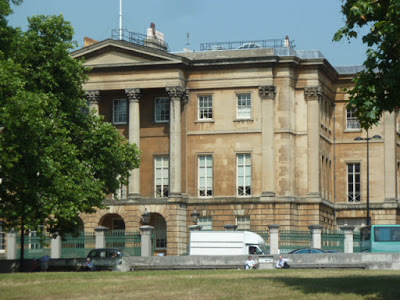
Apsley House, as you may have gathered from our other pictures, is full of artwork. Under the care of English Heritage are the many sculptures, portraits, old masters, and a few contemporary works.
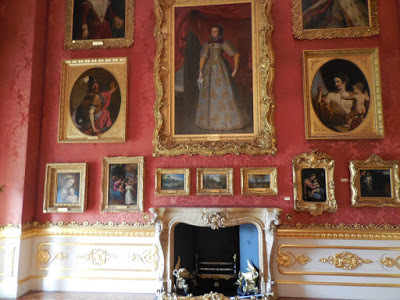 In the Waterloo Gallery; above the mantel, Queen Mary Tudor, after Antonio Moro; frame designed by Wyatt and made by Thomas Temple and Son, about 1830
In the Waterloo Gallery; above the mantel, Queen Mary Tudor, after Antonio Moro; frame designed by Wyatt and made by Thomas Temple and Son, about 1830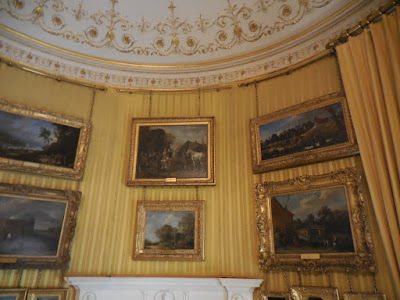 In the Drawing Rooms
In the Drawing RoomsAfter his victory at Waterloo, the Duke of Wellington purchased Apsley House in 1817 from his elder brother, Richard, Marquess Wellesley, who had lived there since 1807. Several years later, Wellington had architect Benjamin Dean Wyatt remodel several rooms to enhance his aim to use the London mansion to entertain as well as to house his collections.
Though the largest number of paintings in the collection come from Madrid, several were presented to Wellington in 1812 by the Intendant of Segovia in gratitude and recognition of his service to Spain in the Peninsular War. Although most of these paintings are elsewhere, several hang at Apsley House.

Head of St Joseph, by Guido Reni (1575-1642)
After the Battle of Vitoria, in Spain just 85 miles from the French border, in June, 1813, Wellington's troops captured the baggage train of King Joseph, the brother Napoleon had appointed puppet king of Spain. Joseph was attempting to take looted paintings from the Royal Spanish Collection to the Louvre in Paris, and in fact he managed to escape with about a dozen. The canvases had been removed from their frames and rolled up, and dozens were found in wagons among manuscripts, ancient books, and other booty.
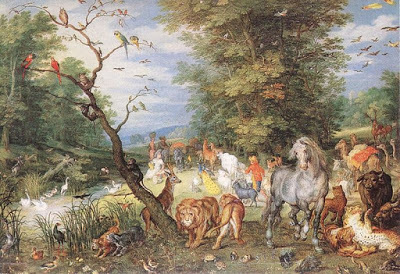 Entering the Ark by Jan Brueghel the Elder (1568-1625)
Entering the Ark by Jan Brueghel the Elder (1568-1625)These captured works were sent to London where Wellington asked his brother William Wellesley- Pole to have them assessed for damage and value. Once the rightful King, Ferdinand VII, was restored to the Spanish throne, Wellington tried to have the paintings sent back to Madrid. However, the King was so grateful to the British, he urged the Duke to keep them, which, after first declining, the Duke eventually agreed to do.
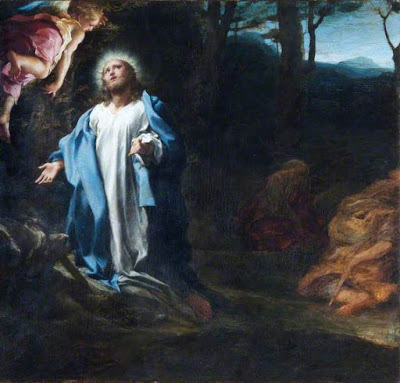 Agony in the Garden, by Antonio Allegri, called Correggio. c. 1525
Agony in the Garden, by Antonio Allegri, called Correggio. c. 1525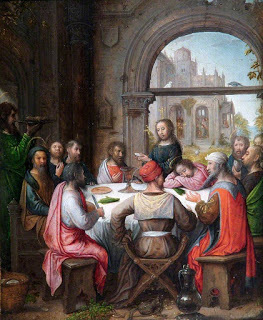 The Last Supper, with the institution of the Eucharist and Christ washing the Disciple's feet, workshop of Juan de Flandes, active 1490's), one of a series of small panels belonging to Queen Isabella of Spain, d. 1504; probably the oldest paining in the collection.
The Last Supper, with the institution of the Eucharist and Christ washing the Disciple's feet, workshop of Juan de Flandes, active 1490's), one of a series of small panels belonging to Queen Isabella of Spain, d. 1504; probably the oldest paining in the collection.Not all of the paintings have a religious theme.
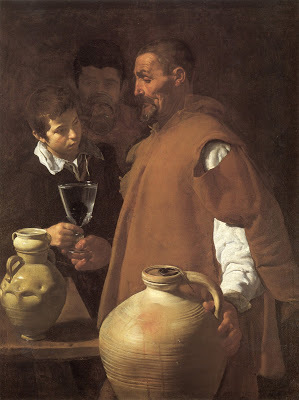 The Waterseller of Seville by Diego Velasquez, C. 1620
The Waterseller of Seville by Diego Velasquez, C. 1620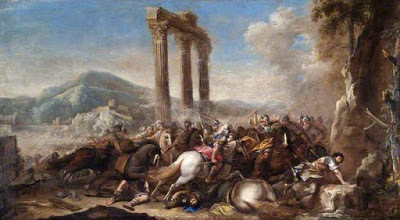 Battle Scene with Classical Colonnade by Salvator Rosa (1615-1773)
Battle Scene with Classical Colonnade by Salvator Rosa (1615-1773)More than eighty of the paintings from the Spajish Royal Collection now hang at Apsley House and most of them can be traced to their acquisition by various Spanish monarchs. Recent cleaning and research on paintings formerly identified as being from the studio or followers of Titian were recently confirmed to be by the master himself, Tiziano Vercellio, c. 1482-1576
.
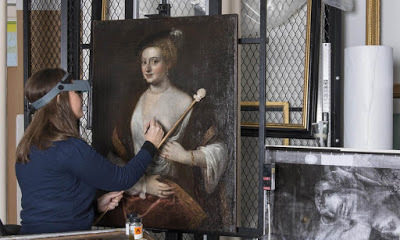 English Heritage restorer works on Titian's Mistress, now cleaned and verified as an actual Titian work
English Heritage restorer works on Titian's Mistress, now cleaned and verified as an actual Titian work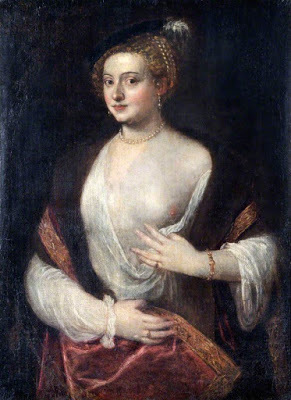 Titan's Mistress
Titan's MistressThe 1st Duke of Wellington purchased paintings at sales in Paris after the war and at several sales of Dutch paintings; While active in politics, he did not buy often, but later, again turned to collecting art in the 1840's.
Dutch landscapes have long been favorites of English nobles.
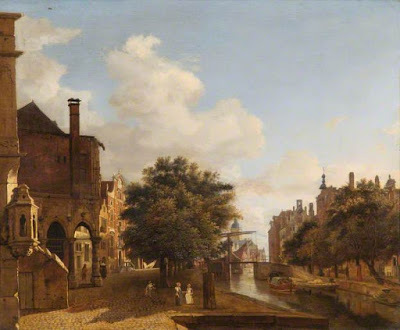 Architectural Fantasy with the Old Town Hall, Amsterdamby Jan van der Heyden (1666-1699)
Architectural Fantasy with the Old Town Hall, Amsterdamby Jan van der Heyden (1666-1699)Some paintings were commissioned by the 1st Duke.
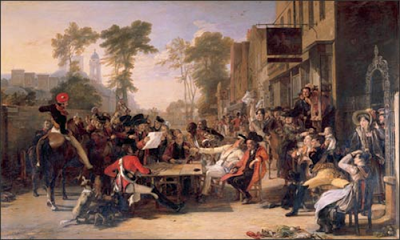 Chelsea Pensioners Reading the Waterloo Dispatch by Sir David Wilkie, RA (1785-1841)
Chelsea Pensioners Reading the Waterloo Dispatch by Sir David Wilkie, RA (1785-1841)Read more about this painting here. The reported price of the painting was 1200 Guineas. The portrait below by Wilkie of King William IV, formerly Prince William, Duke of Clarence, was presented to the Duke by the King
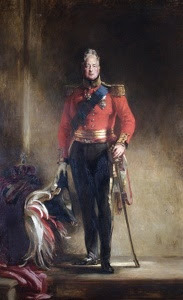 King William IV, by Sir David Wilkie, RA, 1833
King William IV, by Sir David Wilkie, RA, 1833 The 1st Duke also commissioned a painting by Sir Edwin Henry Landseer in 1826, finished three years later in 1829. It was exhibited at the Royal Academy and elsewhere. Its cost was 350 pounds. The Duke was said to be very pleased with the work.
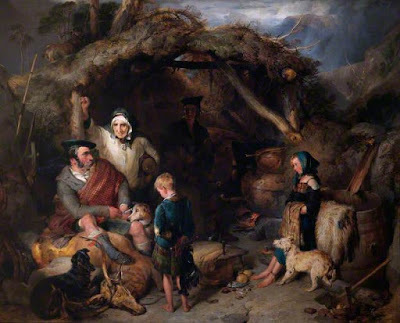 The Illicit Highland Still, by Sir Edwin Henry Landseer, RA,1829
The Illicit Highland Still, by Sir Edwin Henry Landseer, RA,1829As any visitor would expect, many of the artworks in the Wellington Museum collection relate to the 1st Duke's career, his associates, and his victory in the Battle of Waterloo.
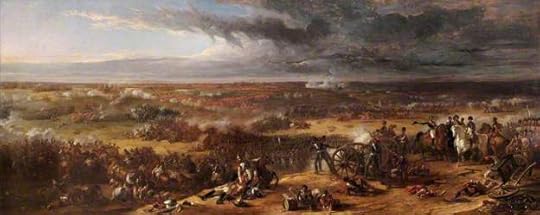 The Battle of Waterloo, 1815, by Sir William Allen, 1843
The Battle of Waterloo, 1815, by Sir William Allen, 1843Allen's panoramic painting shows the view from the French side of the battle, about 7:30 pm, "the last desperate attempt of Napoleon (seen on the right) to force the left centre of the allied army and turn their position. The Duke of Wellington is on the left. He reportedly said of the painting, "Good, - very good; not too much smoke."
Many of the paintings are full length originals or copies by Beechey, Lawrence, and other leading portraitists of the early 19th Century. One example is below.
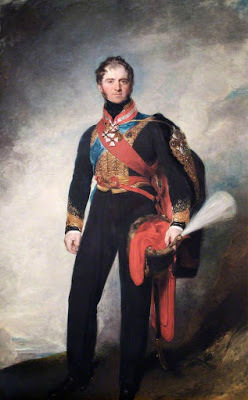 Henry William Paget,(176-1854) 1st Marquess of Anglesey KGby Sir Thomas Lawrence, RA. 1818
Henry William Paget,(176-1854) 1st Marquess of Anglesey KGby Sir Thomas Lawrence, RA. 1818The 1sr Duke purchased some of the oil sketches of Jan Pieneman, who created a huge painting of The Battle of Waterloo, the largest such work in Amsterdam's Rijksmueum.
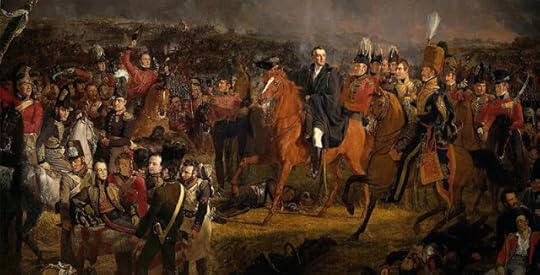 The Battle of Waterloo bu Jan Pieneman, Rijksmuseum; shows Wellington on horseback in center; the wounded Prince of Orange on the lower left.
The Battle of Waterloo bu Jan Pieneman, Rijksmuseum; shows Wellington on horseback in center; the wounded Prince of Orange on the lower left.The oil sketches below are just two of the many the Duke acquired. Pieneman created these works in the early 1820's as life studies for his large painting, finished in 1824. It is on permanent loan from the Dutch Royal Collection to the Rijksmuseum. Some of the oil sketches hang at Apsley House.
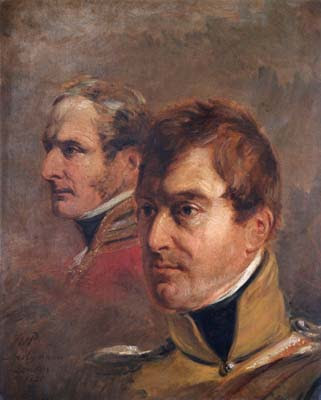 Major General the Hon;Sir Frederick Cavendish Ponsonby (18783-1837)above and left: Major General Sir Colin Campbell (1776-1847)
Major General the Hon;Sir Frederick Cavendish Ponsonby (18783-1837)above and left: Major General Sir Colin Campbell (1776-1847)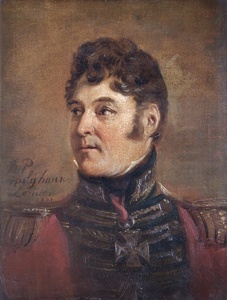 General Sir Colin Halkett, (1774-1856)
General Sir Colin Halkett, (1774-1856)The Duke did not avoid pictures of the French. Napoleon and his first wife Josephine re on display, as well as a portrait of Pauline Bonaparte, Princess Borghese. In 1814 the Duke of Wellington purchased Pauline's mansion in Paris on behalf of the British Government, It is still the Embassy of the United Kingdom in France.
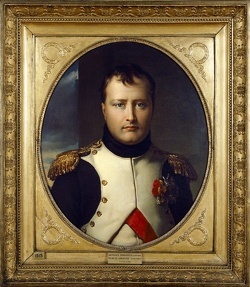 Napoleon Bonaparte by Robert Lefevre (1755-1830)
Napoleon Bonaparte by Robert Lefevre (1755-1830)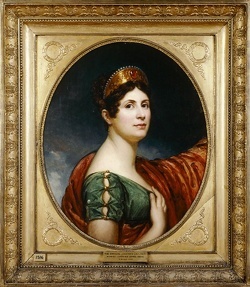 The Empress Josephine by Lefevre
The Empress Josephine by Lefevre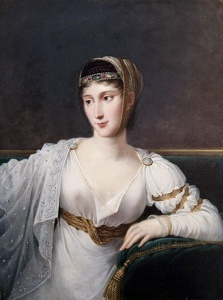 Pauline Bonaparte by Lefevre
Pauline Bonaparte by Lefevre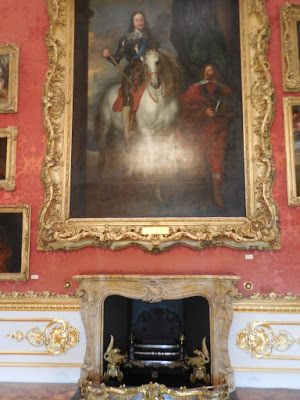 Van Dyke's Charles I, with an unfortunate reflection (not a flash) hanging in the Waterloo Gallery
Van Dyke's Charles I, with an unfortunate reflection (not a flash) hanging in the Waterloo Gallery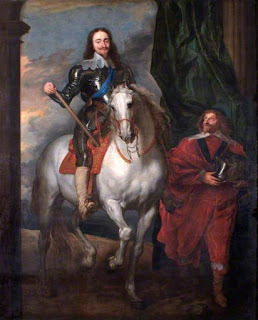 Charles I on Horseback, after Anthony Van DykeThe original is in Buckingham Palace; another version is in Highclere Castle which our tour will see soon
Charles I on Horseback, after Anthony Van DykeThe original is in Buckingham Palace; another version is in Highclere Castle which our tour will see soon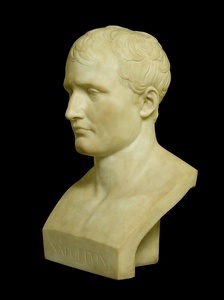 Bust of Napoleon by Canova
Bust of Napoleon by Canova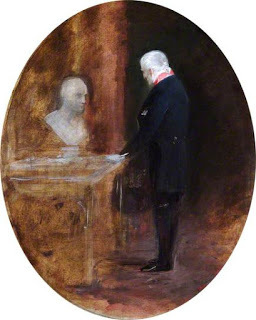 The Duke of Wellington Looking at the Bust of Napoleonby Charles Robert Leslie, RA (1794-1859)
The Duke of Wellington Looking at the Bust of Napoleonby Charles Robert Leslie, RA (1794-1859) 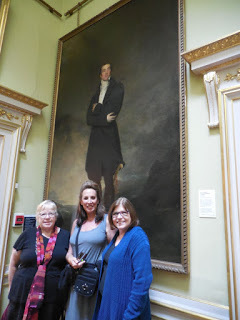 Victoria, Kristine and Diane Perkins pose with the Duke
Victoria, Kristine and Diane Perkins pose with the Duke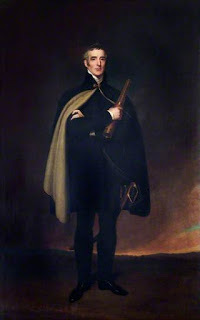 The 1st Duke of Wellington (1769–1852) copy after Thomas Lawrence by Spiridione Gambardella, 1860This is a copy of the painting above, but with an added cape and spyglass.
The 1st Duke of Wellington (1769–1852) copy after Thomas Lawrence by Spiridione Gambardella, 1860This is a copy of the painting above, but with an added cape and spyglass.This post covers a fraction of the fantastic collection at Apsley House, The Wellington Museum. Be sure you put it on your agenda for your next London visit!
Published on June 05, 2015 00:00
June 2, 2015
ARCHITECTURAL DETAILS: APSLEY HOUSE
Published on June 02, 2015 23:30
WE HAVE A WINNER!
Congratulations to Kathleen, whose comment was right on target and who was chosen as the winner of the trade paperback copy of Beaux, Ballrooms, and Battles: A Celebration of Waterloo.
Kathleen, please put your snail mail name and address in a comment on this post (which we will not publish of course), and the book will be in the mail ASAP.
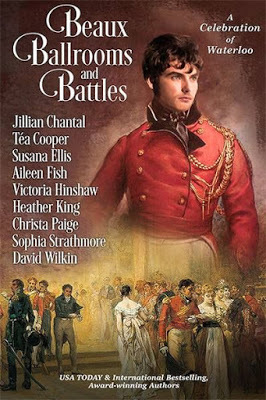
Beaux, Ballrooms, and Battles is available on Amazon and elsewhere -- trade paperback is $14.99. The e-book version, available on most platforms is $2.99.
Below, the Plate about which Kathleen answered three questions correctly. about the image on this Who is the bust? Admiral Lord Nelson
Who is the model portraying? Britannia
And who is the model? Emma, Lady Hamilton,
Thanks to all who entered...
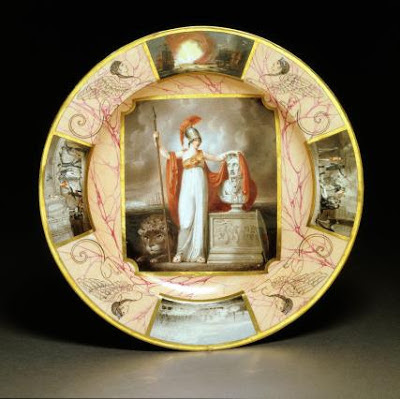
Kathleen, please put your snail mail name and address in a comment on this post (which we will not publish of course), and the book will be in the mail ASAP.

Beaux, Ballrooms, and Battles is available on Amazon and elsewhere -- trade paperback is $14.99. The e-book version, available on most platforms is $2.99.
Below, the Plate about which Kathleen answered three questions correctly. about the image on this Who is the bust? Admiral Lord Nelson
Who is the model portraying? Britannia
And who is the model? Emma, Lady Hamilton,
Thanks to all who entered...

Published on June 02, 2015 07:05
May 31, 2015
GRANDFEST CRAFT FESTIVAL
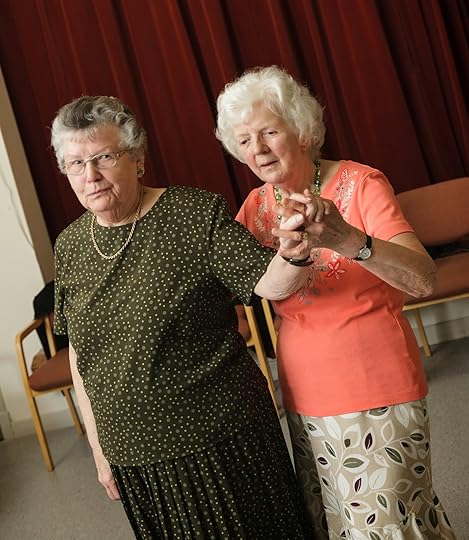
Years of austerity bring new era of ‘make do and mend’
· Latest must-have ‘heritage’ skills include preserve making and home brewing· Older people custodians of crafts now sought after by under 25s· Yorkshire epicentre of bakers, Wales of home brewers and London of crochet experts
‘Heritage’ crafts once written off as old fashioned are experiencing a renaissance fuelled by recent austerity, with the skills possessed by the country’s elders now coveted by the under 25s.
According to research by older people's charity, the Royal Voluntary Service, there is a high level of interest to learn a new skill or craft with 80 per cent of 18-24 year olds saying they would consider learning one if they had the option.
The Royal Voluntary Service commissioned the research to celebrate the launch of GrandFest - taking place in London this June - the UK’s first one day festival created for the older generation to share craft skills such as knitting, crochet, brewing and wooden toy making through a series of master classes.
The skills the under 25 year olds are most eager to master include baking (19 per cent), cooking (22 per cent), ballroom dancing (19 per cent) and knitting (18 per cent). However, on the wish list and also set to make a comeback, are home brewing, preserve making, home grown fruit and vegetables, model making and crochet.
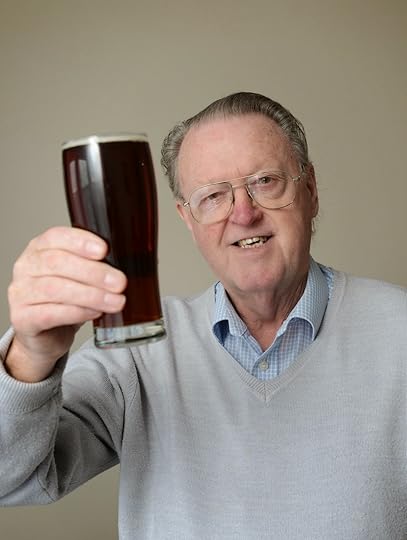
Many of these craft skills are well known to older people, particularly those who lived through the war and grew up in years of austerity, and these ‘original makers’ want to share their know-how. Nearly three quarters (74 per cent) believe it is vital that traditional skills are passed to the next generation to keep them alive.
Particular knowledge gaps currently exist for preserve making (older people are nearly five times as likely to have the know-how), knitting and learning how to ‘grow your own’ (more than twice as likely) and home brewing (nearly twice as likely).
Felicity Kendal, Royal Voluntary Service Ambassador said: “Being able to create something from scratch or ‘make do and mend’ something from old is a valuable skill to possess. It’s wonderful that there is now a surge in demand for traditional crafts such as preserve making and crochet and that through GrandFest there is an opportunity to learn from those who have fine tuned their knowledge over the years.”
Every region is master of a different skill; the East of England is home to the most green fingered Britons capable of growing their own (35 per cent), while cooks (62 per cent) and knitters (23 per cent) are most prolific in the South West, home brewers in Wales (nine per cent), bakers in Yorkshire and Humberside (45 per cent), crochet experts (10 per cent) and ballroom dancers (eight per cent) in London, preserve making in the South East (11 per cent) toy and model makers in the North East (11 per cent).
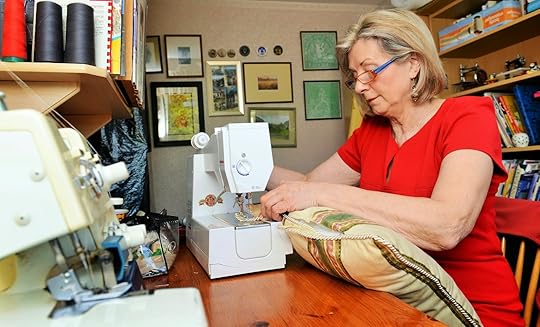
Over half (67 per cent) of over 65 year olds practice at least two hobbies on a regular basis and continuing to enjoy their passion contributes significantly to their health and wellbeing. Fifty seven per cent say it improves their quality of life by benefitting their mental health and 38 per cent, their physical health.
David McCullough, Chief Executive of Royal Voluntary Service said: “We know how much value older people place on their hobbies, but these pastimes are so much more than just fun. They play a really important role in the lives of older people, from staving off fragility and dementia, to helping them keep physically active and bringing friends together. Many of our 36,000 volunteers are over 65 years old and they, and the older people we support, have a wealth of experiences and skills worth sharing which is why GrandFest was conceived.”
Royal Voluntary Service supports over 100,000 older people each month with a range of services from Good Neighbours, Community Transport and Books on Wheels to more interactive services such as Knit and Natter and Men in the Workshop.
The Men in the Workshop service provides a place where older men can come together to recreate local traditional crafts, learn new skills, reminisce and socialise. The workshop also provides opportunities for the wider community to get involved, including the younger generation, to learn from each other, share skills and build friendships.
Tom Wilson, Men in the Workshop member says: “I like doing things, I’m very handy so the workshop keeps me active and using my skills. I also get to meet friends and have some company as I don’t get much at home. You can’t go wrong, everyone is happy. I tell everyone about the workshop, and I get people to buy our items too.”
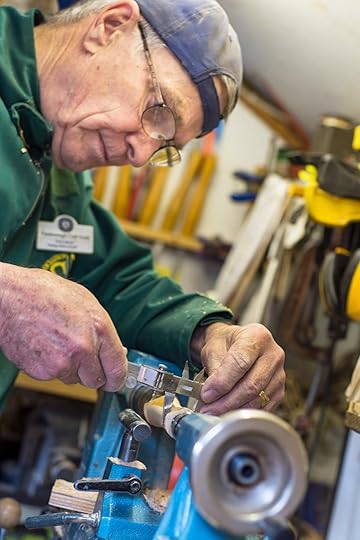
Grandfest, taking place on Saturday 13th June, will see talented older people ‘taking over’ Old Street, home of the hipsters, to host a series of masterclasses. For further information or to book a place in a master class visit: www.Grandfest.royalvoluntaryservice.org.uk
About Royal Voluntary Service
· Formerly known as WRVS, Royal Voluntary Service has been helping people in Britain for 75 years. Originally set up as the Women’s Voluntary Service in 1938, the charity played a crucial role during the Second World War.
Whilst keeping the same values of community service, Royal Voluntary Service has now focused its work on helping older people to remain independent and get more out of life.
Royal Voluntary Service is one of the largest voluntary organisations in Britain with 40,000 men and women helping people in their homes, the community, hospitals and in emergencies.
The charity is a founding member of the Campaign to End Loneliness, a partner in the Big Lottery funded project, Shaping our Age, a supporter of the Malnutrition Task Force and a member of the Care and Support Alliance, the Falls and Fractures Alliance, Age Action Alliance and the Dementia Action Alliance.
Royal Voluntary Service has Investing in Volunteers status in recognition of its good practice and effective volunteer management.
· For more information on the Royal Voluntary Service please visit www.royalvoluntaryservice.org.uk
Published on May 31, 2015 23:30
May 29, 2015
THE DUKE OF WELLINGTON TOUR: NUMBER ONE LONDON (Apsley House)
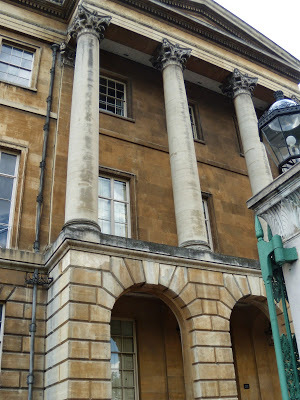
Our tour's first stop was, fittingly, Number One London, the town house of the 1st Duke of Wellington, Apsley House. We arrived before public hours in order to take a private tour given by Christopher Small, who kindly agreed to let us photograph inside. He is a fount of knowledge on the Duke and the Museum, an excellent guide to everything we wanted to know.
For the Apsley House wsebite at English Heritage, click here.
The website has an excellent timeline on the history of the house from its original construction by architect Rovert Adam (1728-92) in 1771 for Henry Bathurst, Lord Apsley, to its present day status as The Wellington Museum.
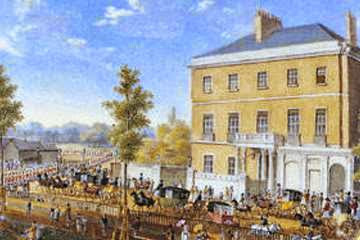 Painting of Apsley House, 1770's
Painting of Apsley House, 1770'sOur post on the 2014 renovations at Apsley house is here.
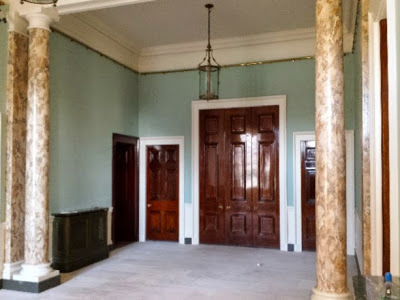
First Christopher took us to see the many gifts and awards the Duke received from grateful governments and monarchs. Here are just a few from the several rooms full of treasure.
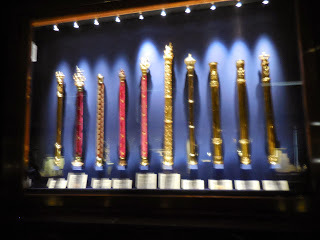 Field Marshal's Batons: decorative accolades from allied nations
Field Marshal's Batons: decorative accolades from allied nations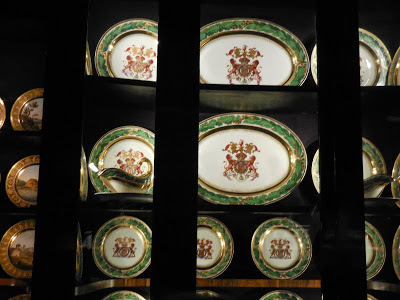 The Prussian Service, with Arms of the Duke of Wellington, 1819
The Prussian Service, with Arms of the Duke of Wellington, 1819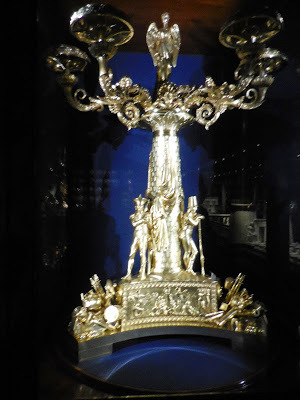 Silver-gilt candelabra
Silver-gilt candelabra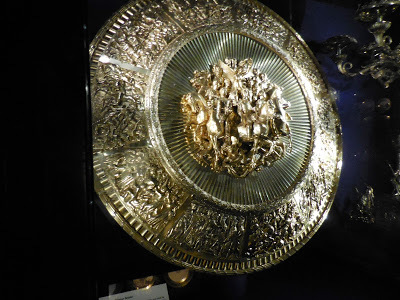 The Wellington Shield, designed by Thomas Stothard, made by Benjamin Smith 1822
The Wellington Shield, designed by Thomas Stothard, made by Benjamin Smith 1822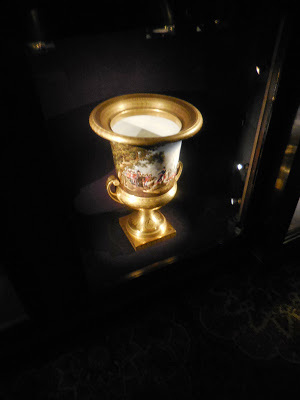 Vase from the Prussian Service, 1819
Vase from the Prussian Service, 1819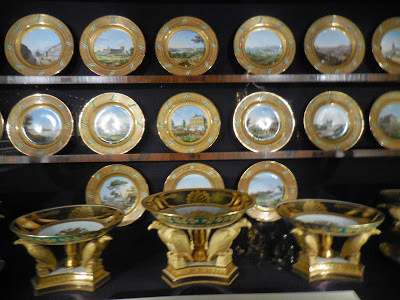 The Saxon Dinner Service
The Saxon Dinner ServiceComing Face to Face with the gigantic statue of Napoleon by Canova, one is amazed first by its size, then by its placement in Apsley House (home of Napoleon's conqueror), then by the complete lack of resemblance to what we know of Napoleon's physique: short and stout, -- and with no vest into which he could insert his hand.
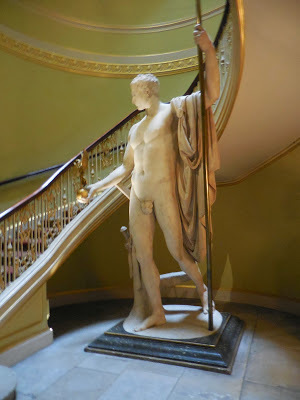
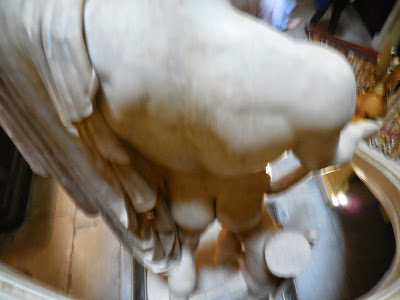
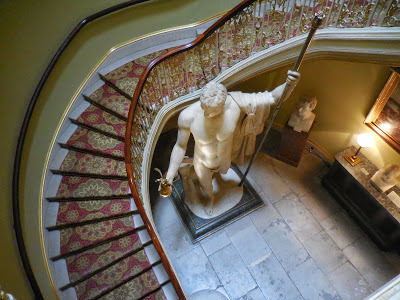
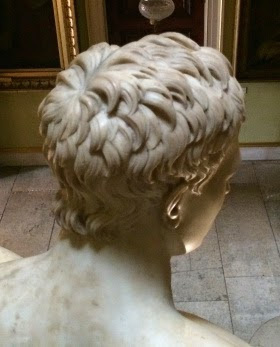
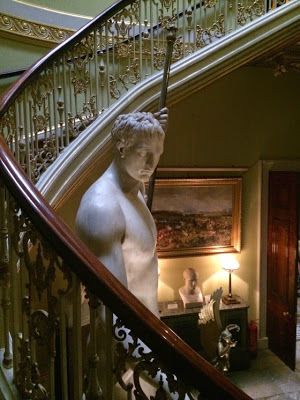
Canova sculpted this image of Napoleon as Mars the Peacemaker between 1802 and 1806. It is said that Napoleon disliked this statue and had it placed in the basement of the Louvre. He found it disrespectful. The British government purchased the statue for 66,000 Francs in 1816; the Prince Regent gave it to Wellington, who figured he might as well find a place for it. When it acquired its fig leaf, I do not know. The floor beneath the statue had to be reinforced in order to hold the heavy marble work, over eleven feet in height.
Click here to read about Victoria's visit in 2011 and what happened when her husband saw it.
The graceful curving staircase is part of the original Adam design. On the principal floor (up one flight) there are four drawing rooms, the State dining room, and the Waterloo Gallery..
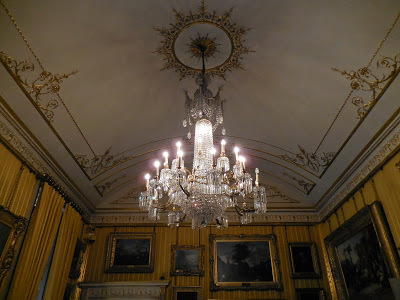 chandelier in the Piccadilly Drawing Room
chandelier in the Piccadilly Drawing Room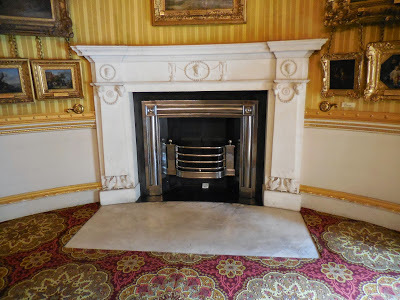 Piccadilly Drawing Room Fireplace by Robert Adam
Piccadilly Drawing Room Fireplace by Robert AdamAccording to the text panel, the Piccadilly Drawing Room was designed in 1774 by Robert Adam; his fireplace, frieze and ceiling ornament remain.
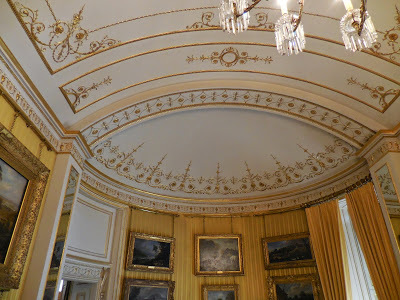 Apse of the Piccadilly Drawing Room
Apse of the Piccadilly Drawing Room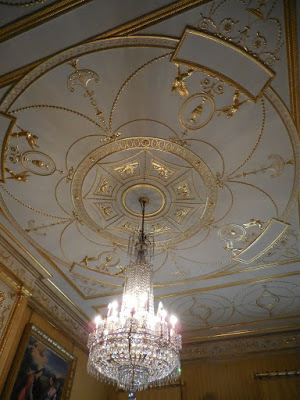 Adam Ceiling of the Portico Drawing Room
Adam Ceiling of the Portico Drawing Room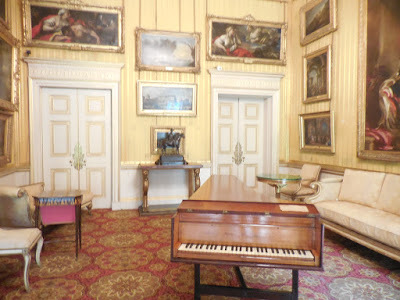
Yellow Drawing room, above and below
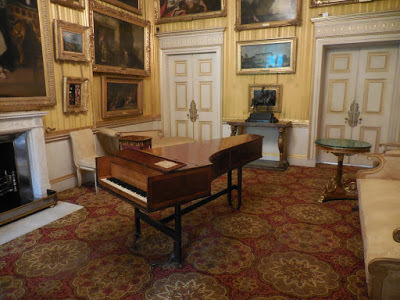
The Striped Drawing Room was adapted by Benjamin Dean Wyatt in the 1820's from a bedchamber and dressing room in the original Adam plan.
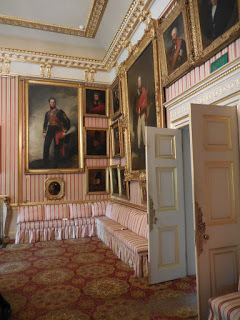
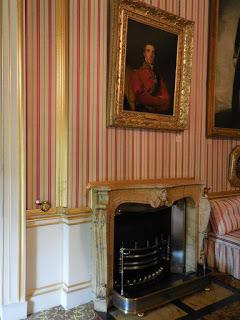
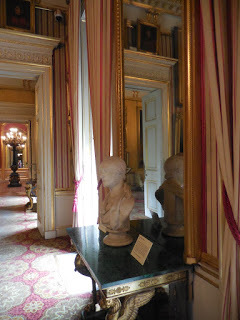 Striped Drawing Room; side table with bust of Prime Minister Spencer Percival
Striped Drawing Room; side table with bust of Prime Minister Spencer Percival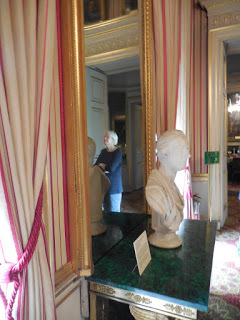 Bust of Prime Minister William Pitt the Younger (and reflection of Marilyn)
Bust of Prime Minister William Pitt the Younger (and reflection of Marilyn)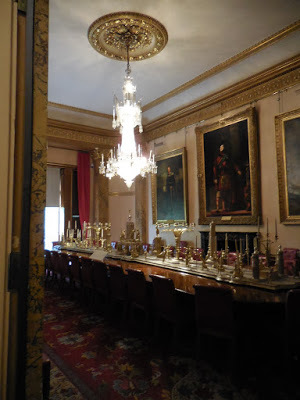 State Dining Room
State Dining RoomThe dining room was added to the Adam building for the Duke in 1819 by architect Benjamin Dean Wyatt. Also included in the addition were bedrooms and dressing rooms, not on display.
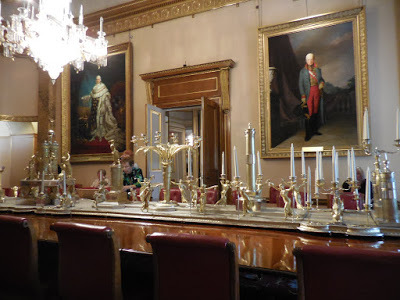 The Portuguese silver gilt service stands as a centerpiece on the dining room table. It was made in Lisbon about 1816 and presented to the Duke for his preservation of Portugal.
The Portuguese silver gilt service stands as a centerpiece on the dining room table. It was made in Lisbon about 1816 and presented to the Duke for his preservation of Portugal.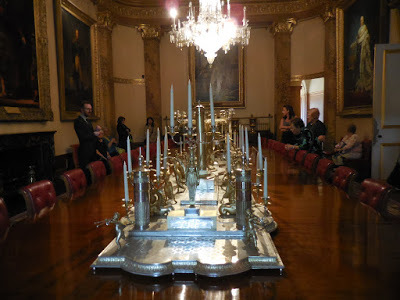 Our excellent guide, Christopher Small,on the left.
Our excellent guide, Christopher Small,on the left.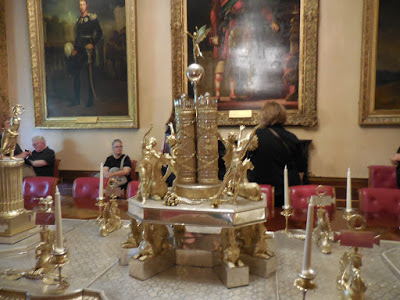
The Waterloo Gallery was a second addition to the original Adam structure, built again by Benjamin Dean Wyatt (1775-1852) in 1828, after the Duke had become Prime Minister. At about 92 feet in length, it provides elegant space for dinners, receptions, and the display of the extensive art collection, about which we shall report soon.
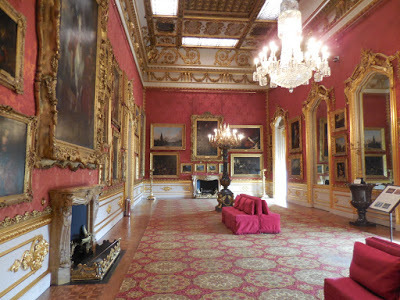
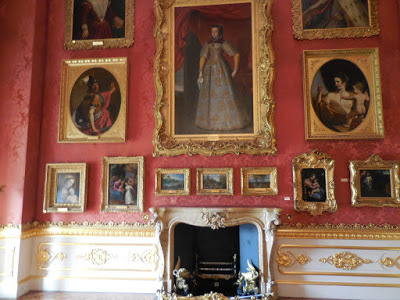
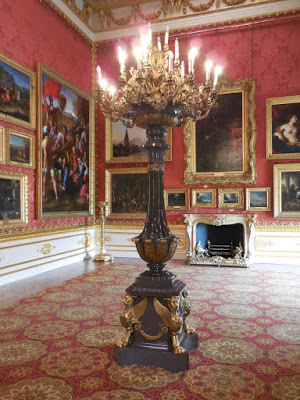
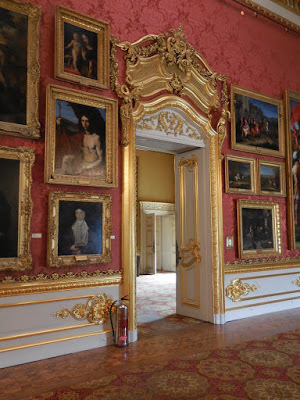
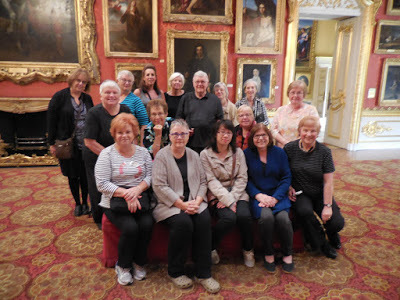 The intrepid Duke of Wellington tour group
The intrepid Duke of Wellington tour group Below, several glass cases held possessions of the Duke and his family.
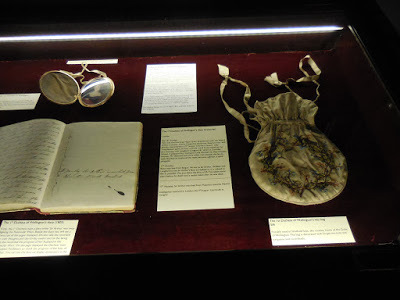 On the right above, the Duchess of Wellington's silk Key Bag
On the right above, the Duchess of Wellington's silk Key Bag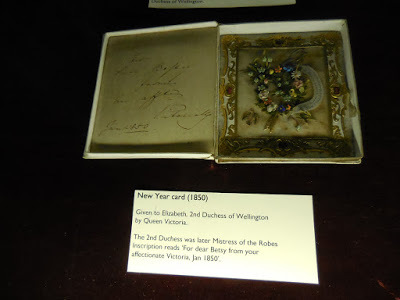 1850 New Year Card from Queen Victoria to Elizabeth, 2nd Duchess of Wellington
1850 New Year Card from Queen Victoria to Elizabeth, 2nd Duchess of Wellington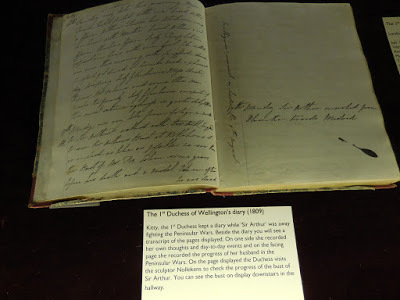 1st Duchess of Wellington' s Diary
1st Duchess of Wellington' s Diary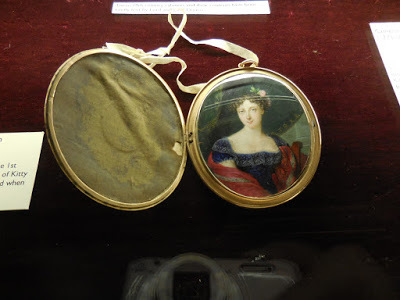 1815 miniature, thought to be of Kitty, 1st Duchess of Wellington at age forty
1815 miniature, thought to be of Kitty, 1st Duchess of Wellington at age forty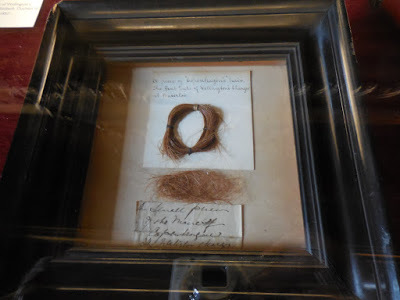 The upper hair is from Copenhagen, the Duke;s charger;below, a small piece of Copenhagen;s mane
The upper hair is from Copenhagen, the Duke;s charger;below, a small piece of Copenhagen;s maneFor more reports on The Duke of Wellington Tour at Apsley House, September, 2014, please stay tuned.
Published on May 29, 2015 00:00
May 26, 2015
WATERLOO WEDNESDAY: WELLINGTON - THE IRON DUKE UNMASKED
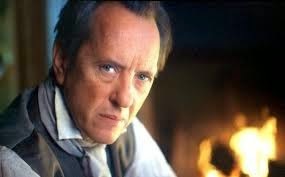
When I first heard that BBC2 were at least going to produce a (vastly overdue) documentary, I let out a hearty Huzzah! And then I began reading bits and pieces on what the film would actually be - a titilating account that would lean heavily towards his reputation "as a rutting stag." Huh? The production-powers-that-be did research into Wellington, his military and political careers, his value to the British Crown through four monarchs, his achievements as a whole and decided to go with his love life instead? Aaaarrrgghhhh!
Now don't misunderstand, I've been studying Wellington's women along with Victoria and Jo Manning for decades. There's some great stuff there, but given the chance to highlight Wellington in a documentary (finally!) I would have chosen to go in a different direction. And with a different actor to play Wellington. Don't get me wrong, Richard E. Grant is a fine actor, but embodies none of Wellington's looks.
The programe introduces Wellington's perceived cruelty towards his wife, Kitty, but gives no hint as to the acrimonious underpinnings of their relationship - the secret mistake Kitty had made early in their marriage that put the first cracks in the bedrock of their marriage. More followed. However, to date no one, not a single Wellington historian, not even the author amongst the Wellesley, Lady Jane, has offered up a single concrete detail about the underlying cause for their rift. A book called, Wellington's Wife, written by a self professed intimate of the family is, perhaps, the book that says the least about their relationship. The second Duke, admittedly, consigned to the fire the cruelest of Wellington's letters to Kitty, so that the ability to say that all documentation about this facet of their lives helps the present day family to preserve what sanctity there was in that marriage. However, I maintain that some items that could shed light on the problems still remain and that, if they truly do not, the Family, at least, know the reasons and have chosen to keep these, or corroborating family lore, to themselves. Which is, after all, their right.
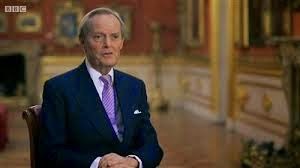
The best parts are the participation of the newest Duke of Wellington and historian Dan Snow.
After actually watching the show, I must say that it was less terrible than I'd feard and more well rounded than I had been lead to believe beforehand. I still hold out hope that someone with the talent necessary will tell this a rich and long story, following the whole of Wellington's fascinating life.
You can watch the hour long program here.
You can read a review of the program from The Telegraph here.
You will find another hour long documentary on Wellington here, presented by author and historian Richard Holmes. which keeps it focus upon Wellington's accomplishments and influences upon the people, places and events of his lifetimel
Published on May 26, 2015 23:00
May 25, 2015
WHO IS THIS?
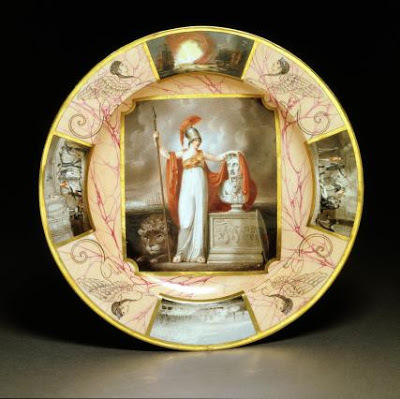
What can you tell us about the image on this plate -- Who is the bust? Who is the model portraying? And who is the model? Three answers, please.
Limited to readers in the U.S. and Canada only
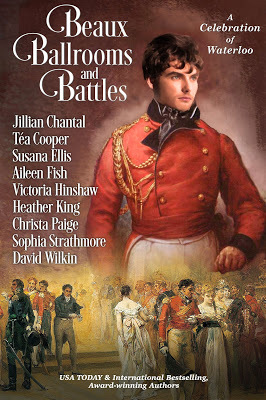
The winner will receive a trade paperback copy of Beaux, Ballroom, and Battles: A Celebration of Waterloo. It contains nine stories by nine authors, all centering on a romance involving the Battle of Waterloo; one is written by Victoria Hinshaw.
We will post the name of the winner (of any, or at random among the correct answers to all three questions) on Monday, May 31. The winner will send us a snail mail address for the prize.
Published on May 25, 2015 00:30
May 22, 2015
THE DUKE OF WELLINGTON TOUR - POST #1: GETTING ORIENTED
Was it possible? All those months of planning and re-planning, posting and re-posting, fretting and re-fretting -- the day was finally here! The Duke of Wellington Tour was underway!
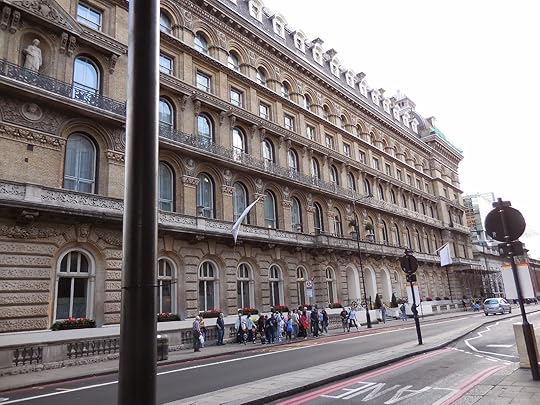
September 4, 2014: All eighteen of us were in London...had arrived at the Grosvenor Hotel...and were ready for tea. We were an eclectic group -- a wide range of ages and a large number of states represented from West to East coast, from Texas to Minnesota. Some of us had been pals for decades, others of us were new to each other. We all shared one goal: to take in all we could of England, of London, of the Duke of Wellington's haunts, and whatever else happened to come our way. Everyone was ready for an adventure.
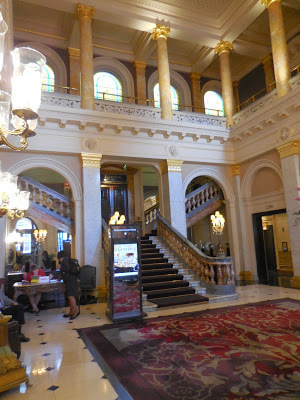 Grosvenor HotelLobby
Grosvenor HotelLobby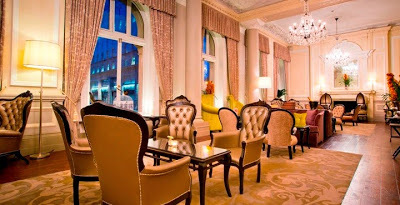 Our first official event was tea in the Lounge: delicious!
Our first official event was tea in the Lounge: delicious!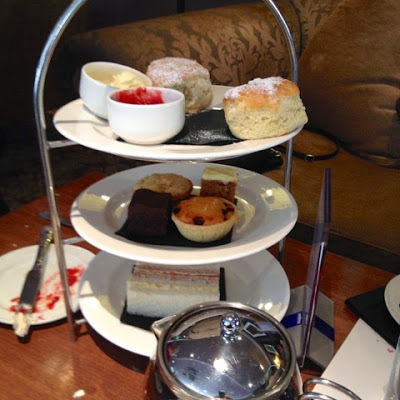 Kathlynn's tea half consumed!
Kathlynn's tea half consumed!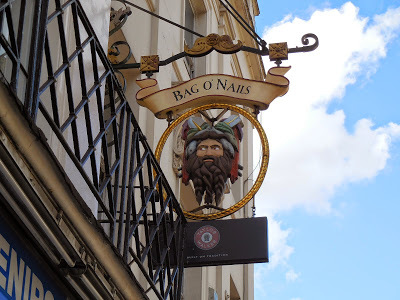
Our second event was not so successful. We tried to take the group on a pub crawl, but the thirsty Friday night after-work Londoners defeated us - there was no room at any of the inns, or pubs, we encountered. So we returned to the Grosvenor's bar and there had plenty of room!
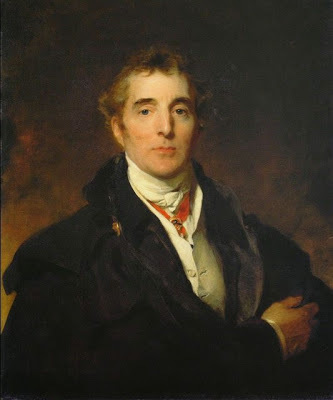 The Duke of Wellington Tour
The Duke of Wellington TourWe had an ambitious itinerary:
Saturday, 9/6: Apsley House, Wellington Arch, Tower of London - Wellington Exhibition, Horse Guards - Dismounting Ceremony, Household Cavalry Museum; Grenadier Pub for dinner
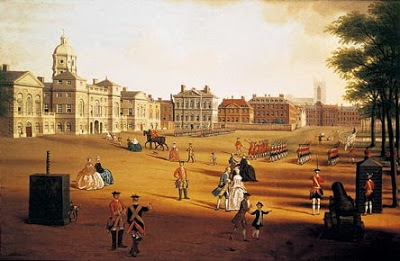 Horse Guards Parade, c. 1760, by John Chapman
Horse Guards Parade, c. 1760, by John ChapmanSunday, 9/7: Walking tour of St. James's or Day at leisure.
Monday, 9/8: Walmer Castle, Dover Castle in Kent
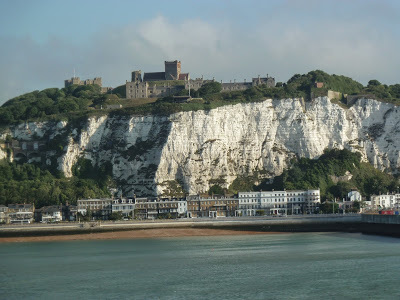 Dover Castle atop the White Cliffs, from the Channel, 2011
Dover Castle atop the White Cliffs, from the Channel, 2011Tuesday, 9/9: Regency Townhouse, Hove; Royal Pavilion, Brighton, Sussex
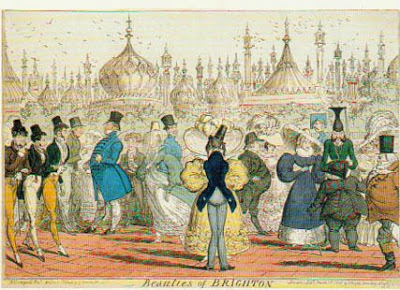 Beauties of Brighton, 1826, by George Cruikshank
Beauties of Brighton, 1826, by George CruikshankWednesday, 9/10: Stratfield Saye, HampshireExplore Reading with Regency Author Beth Elliott
Thursday, 9/11: Highclere Castle, Basildon Park
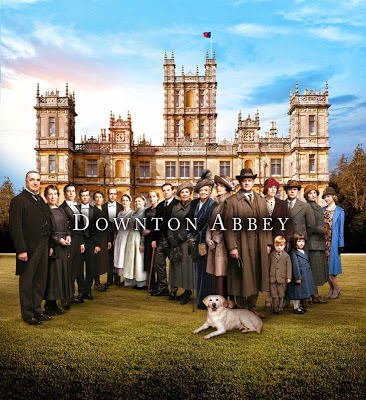 Downton Abbey, AKA Highclere Castle
Downton Abbey, AKA Highclere CastleFriday, 9/12: Windsor Castle/Waterloo Chamber, Guildhall Museum, Berkshire
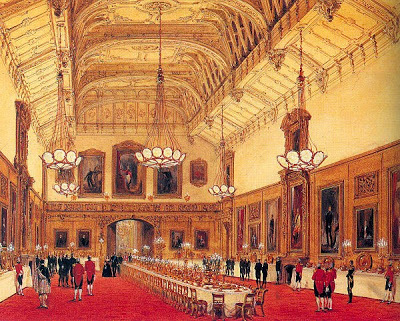 Waterloo Chamber, Windsor Castle, by Joseph Nash, 1848
Waterloo Chamber, Windsor Castle, by Joseph Nash, 1848Saturday, 9/13: Frogmore House; Thames River Cruise
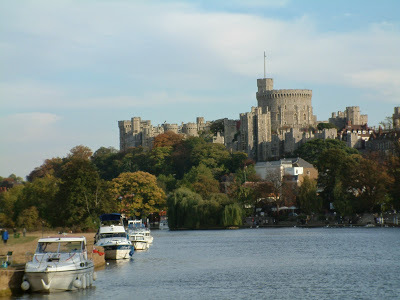 Windsor Castle from the Thames
Windsor Castle from the ThamesSunday, 9/14 Departure -- We shall forget about this aspect of the Tour for the time being -- as we travel leisurely through the rest of the tour events.
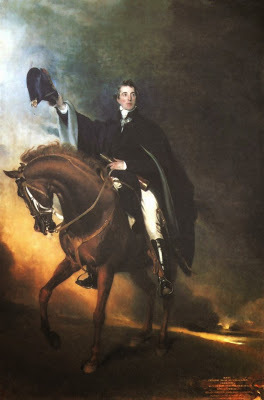
Long live the Duke of Wellington!!!
Follow our Tour Progress on Fridays in May, June, and so forth! Many photo essays to come, as well. We can't wait to begin to relive it all over again while sharing it with you.
Published on May 22, 2015 00:30
May 20, 2015
WATERLOO WEDNESDAY: WAR HORSE - THE REAL STORY
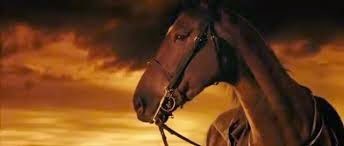
Today we pay tribute to the war horses who fought on both sides during the Battle of Waterloo. If you read through the lists of Regiments who fought at the Battle, you will find that most had a veterinary surgeon assigned to their ranks. For all practical purposes, in the aftermath of the Battle there were hardly enough medical staff to care for the human wounded - hospitals were sadly understaffed and medical supplies lacking. The sheer number of wounded overwhelmed even the most dedicated of the medical staff attached to Wellington, the Allies and the French. Many horses were so badly maimed or wounded that they could not be saved, nor could they be allowed to suffer. Many soldiers who had just witnessed the most horrific human casualties on the battlefield still found the heart to put their equine brothers in arms out of their misery in the hours after the Battle.
Of course, there is no visual record of the bonds that were forged between soldiers and their mounts at Waterloo other than, perhaps, the Duke of Wellington's own bond that was forged with his horse, Copenhagen, with whom he shared command during the Battle. After living out his retirement at the Duke's country estate, Stratfield Saye in Hampshire, Copenhagen was buried with full military honours, his grave and tombstone still to be seen on the property.
Pure History Specials: War Horse - The Real Story (60 minutes) is a superbly made documentary that uses period film, first hand accounts and historians to tell the story of how the soldiers of World War I lived, cared for and fought with their horses and sheds light on the day to day bond they shared and the attachments they forged with these equine brothers, and sisters, in arms. Though WWI took place one hundred years after Waterloo, we can't help but believe that things hadn't changed all that much during the intervening century and that what held true in 1815 held true in 1914.
Here is a five minute clip of the British Heavy Cavalry from the film Waterloo (1970) with Christopher Plummer as Wellington.
Published on May 20, 2015 00:00
May 18, 2015
LOOSE IN LONDON: PUB SIGNS WE SAW ALONG THE WAY
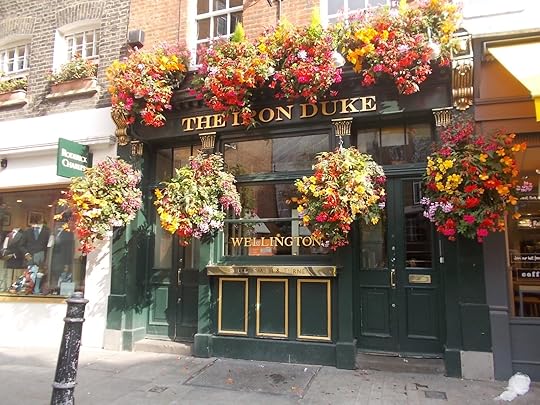
Another Wellington pub, this one near Savile Row.
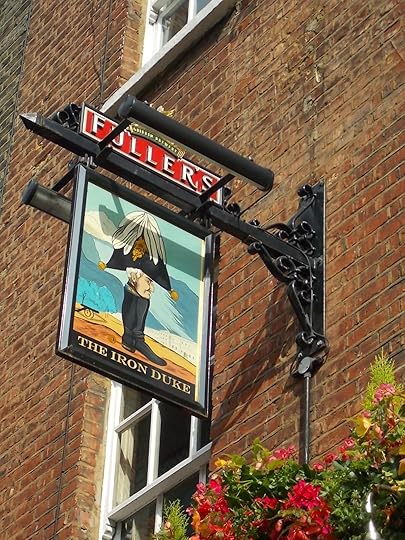
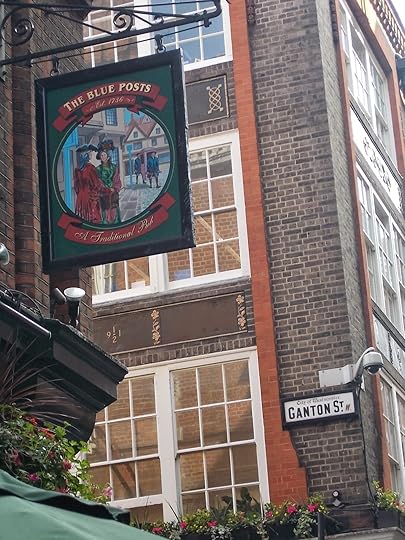
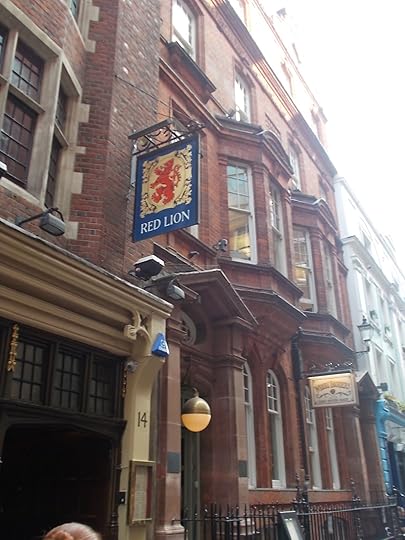
14 King Street, just doors away from Almack's.
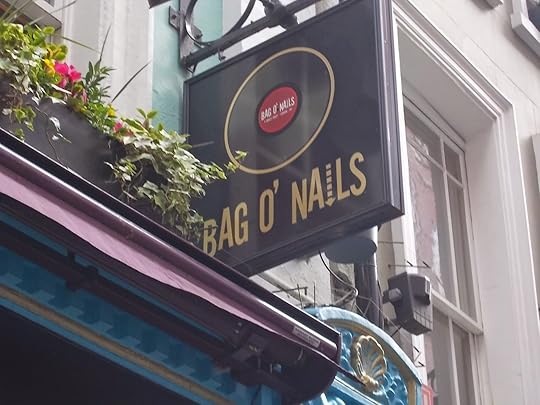
Another Bag O' Nails, not to be confused with our local near the Palace.
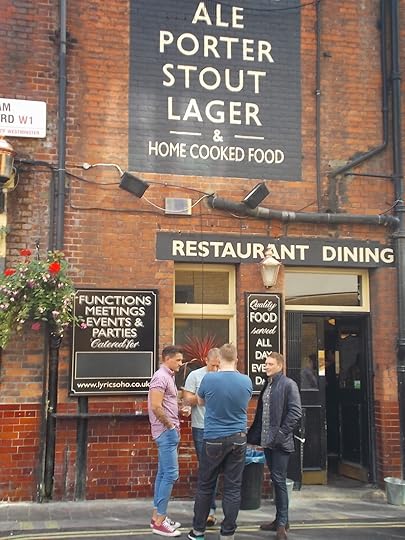
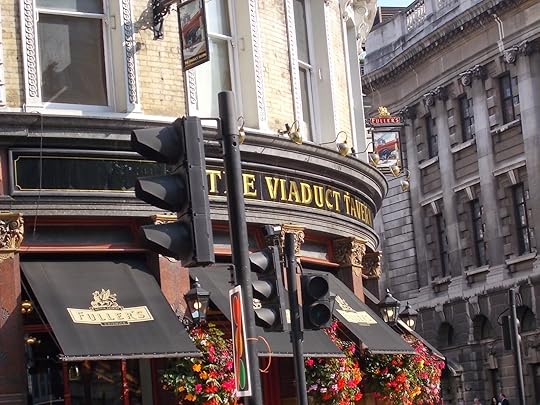
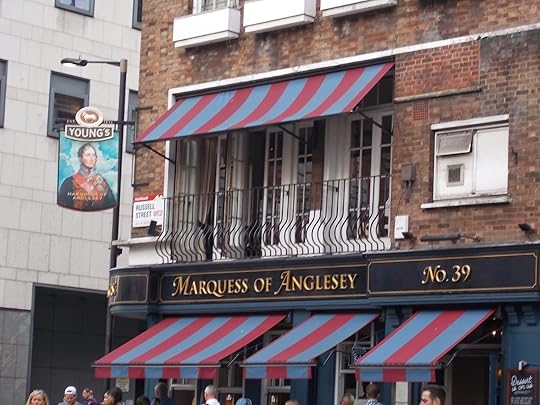
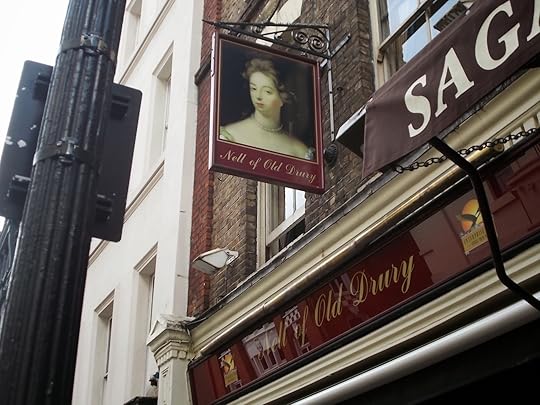
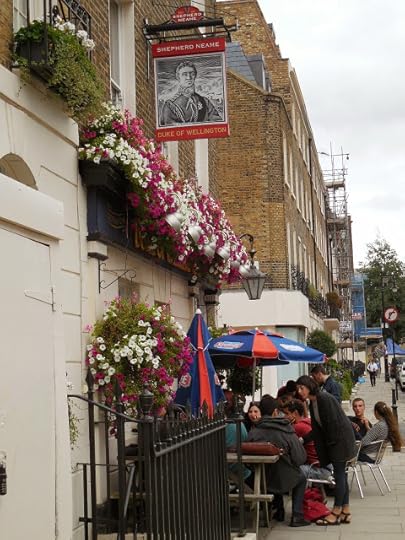
The Duke of Wellington, near our hotel in Kensington Square
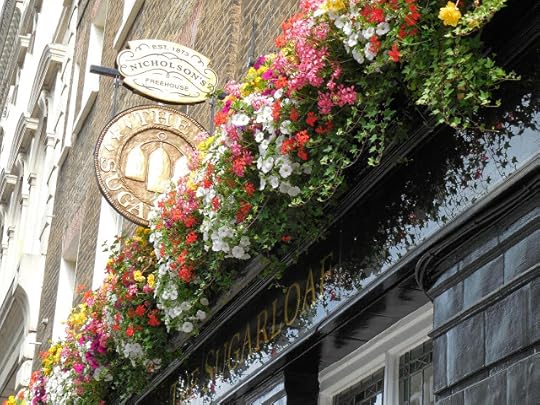
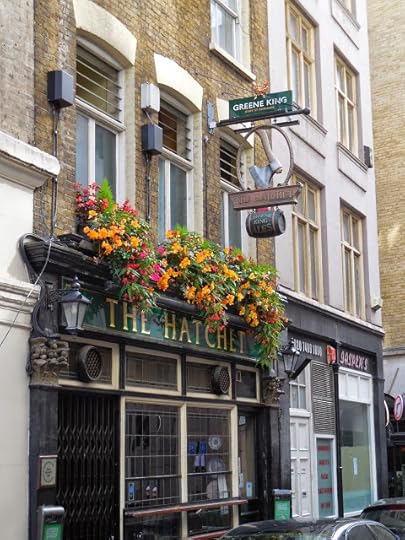 The Hatchet
The Hatchet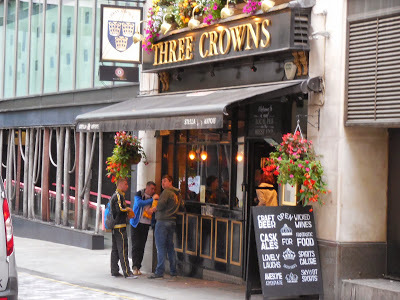
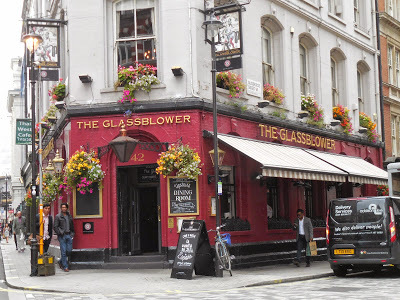
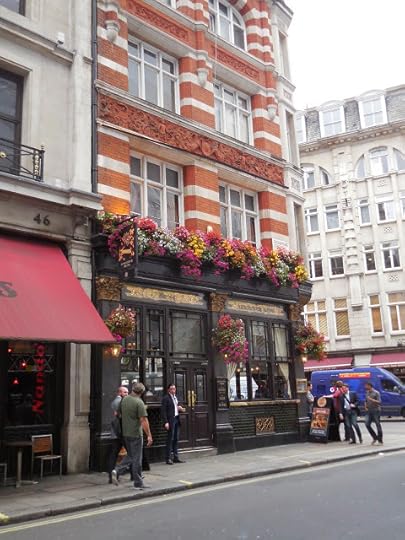 Leicester Arms
Leicester Arms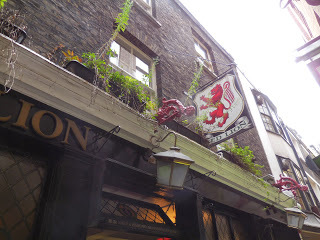 Red Lion
Red Lion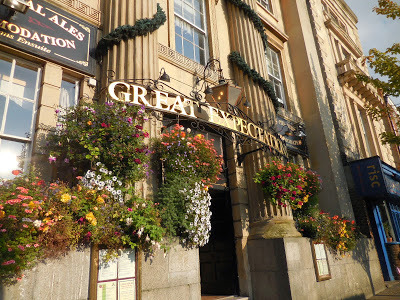 Great Expectations in Reading
Great Expectations in Reading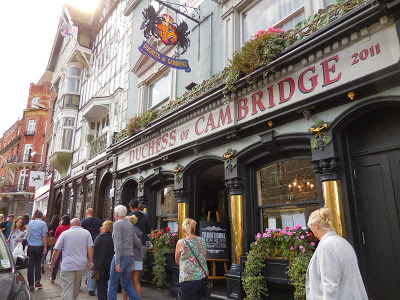
Duchess of Cambridge, Eton
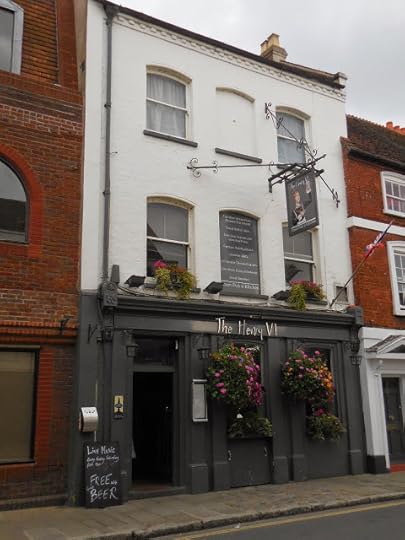 The Henry VI, Eton
The Henry VI, Eton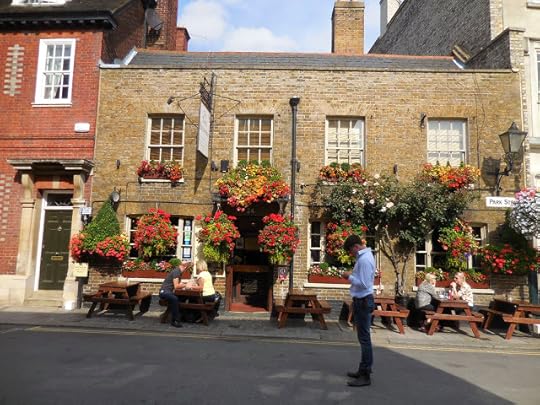 The Two Brewers, Windsor
The Two Brewers, Windsor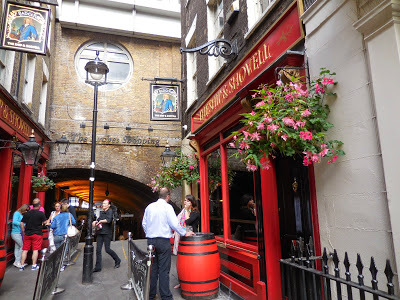 The Ship and Shovel
The Ship and Shovel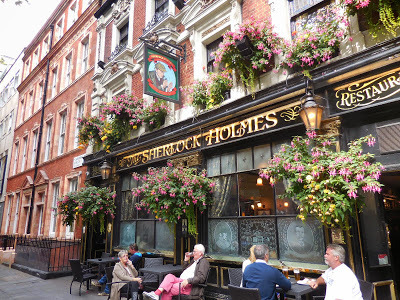 The Sherlock Holmes, London
The Sherlock Holmes, London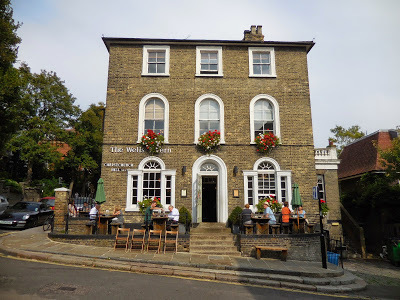
The Wells, Hampstead, where Victoria had lunch and Kristine managed to choke down some bread and butter. But that's another story . . . . .
Published on May 18, 2015 00:00
Kristine Hughes's Blog
- Kristine Hughes's profile
- 6 followers
Kristine Hughes isn't a Goodreads Author
(yet),
but they
do have a blog,
so here are some recent posts imported from
their feed.



















